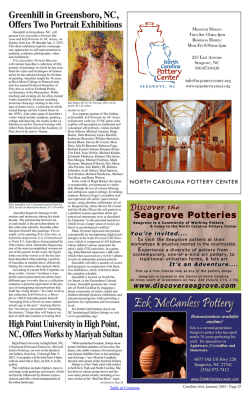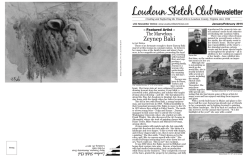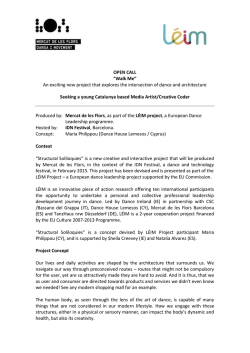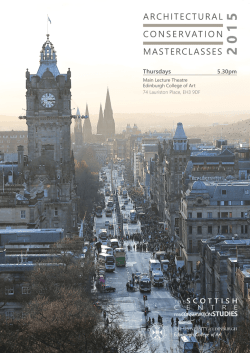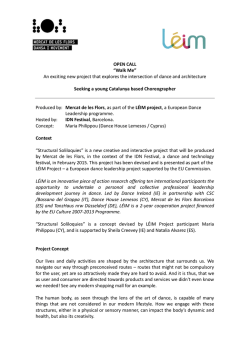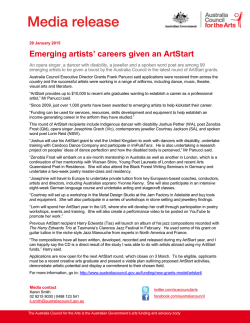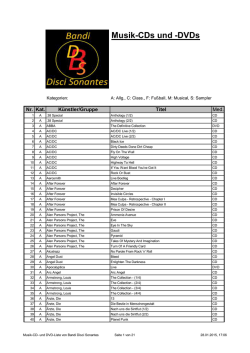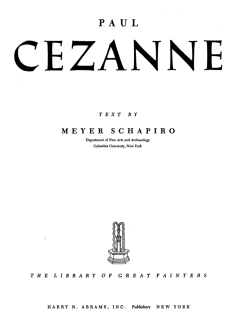
Undergraduate Art History Course Descriptions Spring 2015
Undergraduate Art History Course Descriptions Spring 2015 ARTH 111 Introduction to Art History Monday 7:00 pm – 9:40 pm This course is designed to provide students not only with an introduction to major historical periods and cultures, styles, techniques and theoretical issues in the history of art, but also with an understanding of the ways in which art and artists both shape and are shaped by the cultures in which they operate. We will focus on key art-historical periods and cultures, and a sampling of artworks and monuments most characteristic of each period and culture, as well as on the methods of art history: visual analysis, descriptive and analytical writing, and important terms and concepts. In addition, all weekly lectures and discussion sections will have a thematic component focused on the relationship between the creators of art and the societies in which they lived and worked. ARTH 205 Egyptian Art Edward Bleiberg [email protected] Monday 7:00 pm – 9:40 pm 1527 HN Egyptian art emerges from rock art by the mid-fourth millennium BCE. Within the first five hundred years of its 4,000 year history, Egyptian artists established basic means of communicating political, social, and religious ideas through images. This course leads students through this development and the elaborations and innovations that subsequent Egyptian artists contributed to this system. Students will become familiar with the most important monuments of Egyptian art and architecture including sculpture, relief, painting, tombs and temples. They will learn to interpret material culture as historical evidence and will come to understand Egyptian concepts of style and iconography. ART H 221 Late Medieval Art E. Monti [email protected] Tuesday 9:45 am – 12:25 pm 1501 HN Taking its start from the revival of European culture about 1000 (when the turmoil caused by the Viking invasions subsides), this course concentrates on the creative impetus Romanesque and Gothic periods. It concludes with the achievement of High Gothic (ca. 1250). Although the art and architecture of other countries is discussed, the principle emphasis is on the pivotal work in France. The course includes due consideration of changing historical circumstances, such as the reinforcement of the authority of monarchy and the emergence of communes, the history of ideas, relationship to Scholasticism and the like. ARTH 227 Van Eyck to Breugel: Introduction to Northern Renaissance Art Nathaniel Prottas [email protected] Tuesday 4:00 pm – 6:40 pm 1527 HN This course explores the artistic production of the Low Countries, Germany, and France 1 in the fifteenth and sixteenth centuries, including painting, sculpture, manuscripts, metalwork, tapestries, and printmaking. The course will focus on a range of topics, including: technical innovations in art production such as the ‘invention’ of oil painting and engraving, art’s devotional function, the complex relationship between naturalism and symbolism in Northern art, the hermeneutics of vision (that is, the way pictures structure processes of interpretation), and the relationship between Northern and Italian Renaissance art. We will also consider the changing market for art in this period from the courtly sphere of conspicuous consumption to the rise of new secular pictorial genres, such as landscapes, market and peasant scenes in urban markets like Antwerp and Nuremberg, as well as the impact of the Reformation on the manner and meaning of the visual arts in the Low Countries and Germany. ARTH 230 High Renaissance and Late 16th Century Art in Italy Patricia Rocco [email protected] Thursday 1:10 pm – 3:50 pm 1501 HN This course will explore the art of the second half of the Renaissance, beginning with Leonardo and Michelangelo in the high Renaissance, and ending with Mannerist artists such as Bronzino. We will look at the work of artists from the 16th century while examining the sites for which the art was produced, including both public architecture and domestic space in cities such as Florence, Rome and Bologna. The course will focus on themes such as naturalism and the revival of antiquity, piety, and the censorship and reform of visual imagery, while engaging with various media from painting and sculpture to decorative arts. In addition, we will discuss the commissioning of art in this period as part of a program of political and religious propaganda, while also examining the Renaissance from the point of view of Northern artists such as Durer. Requirements include weekly readings and class discussion, a critical writing assignment, 2 exams, and a trip to the Metropolitan Museum. ARTH 235 Southern Baroque Professor Ellen Prokop [email protected] Monday 7:00 pm – 9:40 pm 1501 HN This course surveys the painting, sculpture, architecture and prints produced in southern Europe during the seventeenth century. Although it aims to be comprehensive, many lectures will concentrate on seminal figures of the period, including the painters Caravaggio, Diego de Velázquez and Nicolas Poussin; the sculptor and architect Gianlorenzo Bernini; and the architects Francesco Borromini, Guarino Guarini and Louis Le Vau. Central subjects of early modern art such as religious architecture, CounterReformation iconography, court portraiture and the rise of genre painting be examined, and crucial issues of cross-cultural exchange, patronage and collecting will be debated. The course will also explore how ideologies, politics and socio-economic conditions affect the visual arts. Assigned readings will include one survey textbook supplemented by several short articles and excerpts from primary source documents. Requirements include two 2 examinations, one short (approximately 1,000 words) research paper and active class participation. ARTH 243 18th Century Art Kim De Beaumont [email protected] Monday 1:10 pm – 3:50 pm 1501 HN This survey of European art from around 1700 to 1790 will focus primarily on Italian, French, and British art, stressing the interplay of distinctive national developments and major international trends. Special attention will be given to the role of the Enlightenment and other complex political, literary, and cultural forces in transforming life and thought in Europe throughout the period. The “hierarchy of genres” imposed by artistic academies will be considered in relation to the increasing pluralism of artistic activity among celebrated artists and many lesser known figures. It was in mideighteenth-century Paris and London that the art world as we know it today began to emerge, with its focus on art exhibitions and auction houses, published art criticism and appreciation for art among a growing middle-class public. Outstanding achievements in sculpture and architecture, as well as the decorative arts and book illustration, will be addressed. Course requirements include mid-term and final examinations in essay format, and a 6-10 page term paper on a work of eighteenth-century art in a New York museum. ARTH 244 Neo Classicism and Romanticism Vivianna Bucarelli [email protected] Thursday 9:45 am – 12:25 pm 1527 HN This course will focus on two important and simultaneous artistic movements from the late eighteenth and early nineteenth centuries, Neoclassicism and Romanticism. We shall evaluate specific examples from painting, sculpture, architecture, printmaking, and decorative arts from a variety of countries. We will examine the works of numerous artists, including Jacques-Louis David, Antonio Canova, Jean Auguste Dominique Ingres, Francisco de Goya, Joseph Mallord William Turner, Caspar David Friedrich, Eugène Delacroix, among many others, and consider them in their political, social, economic, spiritual, and aesthetic contexts. ARTH 246 American Painting Kevin Avery [email protected] Monday 4:00 pm – 6:40 pm 1527 HN This course illuminates the major masters and movements in American painting from about 1760 to 1900, tying trends in artistic expression to contemporaneous historical and cultural manifestations and transitions during the birth and earlier history of the United States. The course concentrates on major masters in the principal genres of painting during the period: in portraiture, John Singleton Copley, Gilbert Stuart, and Charles Willson Peale, James A. M. Whistler, Thomas Eakins, and John Singer Sargent; in historical and narrative painting, Benjamin West, Copley, John Trumbull, William Sidney Mount, Eastman Johnson, and Winslow Homer; and in landscape, Thomas Cole, Frederic Church, and other representatives of the so-called Hudson River School. Also 3 included are late nineteenth-century trends such as American Impressionism and Romantic Expressionism, exemplified respectively in the works of such artists as Childe Hassam and Albert Pinkham Ryder. ARTH 247 Latin American Art Iliana Cepero-Amador [email protected] Thursday 1:10 pm – 3:50 pm 1527 HN ARTH 250 20th Century Art II Viviana Bucarelli [email protected] Friday 1:10 pm – 3:50 pm 1527 HN This class will address the major movements and artists in the U.S., Europe, and internationally between 1945 and the early 1980s. Emphasis will be placed on the specific historical contexts of production and reception determined by such phenomena as the Second World War, expanding commodity culture, and the civil rights movements of the 1960s. We will trace the multiple narratives of postwar modernism and attempt to connect changes in aesthetic theory with historical conditions. Topics will include Abstract Expressionism, its origins and legacies, Neo-Dada/Pop, Minimalism, Conceptual art, performance, early video, and international movements such as informal, Art Brut, New Realism, Arte Povera, Gutai, and Neo-Concretism. Emphasis will be on analysis of the readings. Writing assignments are on topics of each student’s choice. ARTH 251 Contemporary Art Meredith Mowder [email protected] Wednesday 1:10 pm – 3:50 pm HN 1527 The goal of this course is to help students develop an understanding of key themes and artists in contemporary art and theory, as well as facilitating a familiarity with the language of contemporary art and art criticism. First and foremost, we will seek to answer the question, what is contemporary art? Looking at key works, artists, common themes, and contexts from the 1960s to now, we will establish a firm historical base for answering the aforementioned question. Our class meetings will consist of a lecture and time for discussion of the weekly readings. ARTH 256 Modern Architecture II Anna Jozefacka [email protected] Tuesday 7:00 pm – 9:40 pm 1527 HN The lecture course surveys architecture from the 1950s to the present. It opens with Modern architecture’s transition from being avant-garde expression to its institutionalization in large scale commercial and government projects. It concludes by seeing Modernist form as one of many alternatives, including post-modernism and deconstructivism. The course addresses the ever-diversifying language of Modern architecture, with its global reach and regional variations. In addition, it outlines the ways 4 Modern architectural theory and practice have been systematically challenged since the 1960s and augmented by emerging architectural theories. Focusing primarily on architecture, but including other related disciplines such as urban planning and applied arts and design, this class introduces students to the main theories and their protagonists of the various architectural movements that shaped the course of architectural theory and practice during this period. ARTH 261 Chinese Painting and Calligraphy Wen-Shing Chou [email protected] Tuesday 1:10 pm – 3:50 pm 1527 HN As the second part of a year-long sequence on art of East Asia, this course surveys the emergence and development of the arts of the brush from the 3rd to the 20th century, with an emphasis on the last millennium in China. Topics will include media, methods, and techniques of the arts of the brush, formation of artistic canons, the practice of copying, theories on representation, foundation of imperial painting academies, practices of connoisseurship and collecting, emergence of the literati tradition and its spread to Korea and Japan, the interplay between painting and calligraphy, antiquarianism and selfexpression, encounters with non-Chinese traditions, the transition from social realism to abstract lyricism, and engagement with the painterly and written tradition in contemporary Chinese art. ARTH 300.01 Research Methods: Latin American Art in New York Collections Harper Montgomery [email protected] Tuesday 9:45 am – 12:25 pm 1502 HN In this course we will draw on New York collections to examine twentieth-century Latin American art. Beginning with the 1920s and ‘30s, we will look at various approaches to representing national themes in Mexico, Argentina, and Brazil. We will then examine the rise of abstract tendencies in Uruguay, Brazil, and Venezuela during the 1940s and ‘50s, ending the chronological scope of our inquiry in the 1960s and ‘70s with discussions of artists’ experiments with Conceptualism and Performance art. Artists’ diverse approaches to making prints, paintings, and sculpture will be analyzed in the broadest manner, with special attention paid to their interests in politics, the body, and design and architecture. In addition to familiarizing ourselves with the histories of art in twentieth-century Latin America, our task will be to study methods of art historical inquiry and to acquire the skills necessary for writing a research paper focused on a single work of art. For this purpose, each student will be assigned a work from the Colección Patricia Phelps de Cisneros or the Museum of Modern Art. Works will be drawings, photographs, sculpture, and paintings by key historical figures, including Diego Rivera, Frida Kahlo, José Clemente Orozco, Xul Solar, Jesús Raphael Soto, Gego, and Hélio Oiticica. Requirements for the course include regular research and writing assignments, an in-class oral presentation, and a ten to fifteen-page research paper. Readings and class discussions will introduce you to methods for interpreting works of art and assignments will focus on strategies for clear and compelling writing. Three classes will be held outside the 5 classroom. One at Crozier Fine Arts, where works from the Colección Patricia Phelps de Cisneros will be displayed for the class, a second at the Museum of Modern Art, and a third at the Watson Library of the Metropolitan Museum of Art where the reference librarian will conduct a workshop on researching printed and electronic media. ARTH 300.02 Research Methods: New York Architecture Anna Jozefacka Wednesday 4:00 pm – 6:40 pm 1501 HN Using architecture of New York City as the area of inquiry, this class will familiarize students with various methodologies and theoretical models (critical theories) that art and architectural historians have developed to analyze painting, sculpture, and architecture. Intended for upper level art history majors, this class is designed to help students acquire analytic and interpretative skills for the discussion of art and architectural works. It will also provide aid toward the acquisition of effective academic research and writing skills. For these reasons, the class is organized around a series of workshops and exercises that focus on practical aspects of researching, writing, editing, and presenting an art history paper that is based on a specific object, in the case of this class, a building. At the beginning of the semester, each student will be assigned a building located in New York, which he/she will analyze and research during the course of class. The result of his/her effort will be a research paper and a new contribution to the field of architectural history. ARTH 311.02 Sp Tpcs in Ancient Art: Pre Columbian Amanda Gannaway [email protected] Tuesday 7:00 pm – 9:40 pm 1501 HN The arrival of Spanish conquistadors to the Americas during the first half of the sixteenth century precipitated the collapse of two famously powerful and extensive empires, one based in central Mexico and ruled by the Aztec and the other centered in highland Peru and governed by the Inka. Both of these impressive civilizations were preceded by thousands of years of rich cultural development. This course will introduce students to the diversity of artistic traditions that flourished in the ancient Americas during the period before European contact. The material covered by this survey dates from the earliest known pre-Columbian cultures to the fall of the great empires and includes art and architecture from Mesoamerica (Mexico, Belize, Guatemala, Honduras) and the Central Andes (Ecuador, Peru, Bolivia). Students will learn how selected works operated in their original contexts through consideration of the aesthetic strategies and the materials and technologies employed in their creation. They will also explore some aspects of the postconquest legacy of pre-Columbian art through its reinterpretation by later artists and its representation in contemporary popular culture and media. 6 ARTH 311.03 Sp Tpcs in Ancient Art: Byzantine A.L. McMichael [email protected] Thursday 4:00 pm – 6:40 pm 1527 HN This course will cover art and architecture from Byzantium, which was the Eastern Roman empire c. 313-1453 CE. Lectures and class discussions will cover a variety of special topics. These include Icons and Iconoclasm; Visuality (social practices of viewing); Materiality and the processes of making art; and Commemoration, including the Cult of Saints and rituals with in architectural spaces. We will analyze a number of sources, both textual and material. We will also consider the contexts in which we view and exhibit Byzantine art, looking to develop a critical perspective on the medieval Mediterranean within the art historical canon. There will be weekly readings and discussions and a final exam. This is a writing intensive course, so students will produce about 15 pages of work (including workshops and revisions). ARTH 341.03 Sp Tpcs in Baroque Art: Vermeer and his Contemporaries Kim De Beaumont [email protected] Thursday 7:00 pm -9:40 pm 1501 HN Johannes Vermeer (also called Jan; Delft 1632-1675 Delft), today revered for his crystalline and meditative representations of figures in contemporary interior spaces, is known to have produced only about 35 paintings in his lifetime. His oeuvre stands apart from those of numerous far more prolific and prosperous contemporary Dutch artists who specialized in scenes of everyday life. In this course we will consider the evolution of Vermeer’s art—from early biblical subjects, to such iconic works as The Milkmaid (c. 1658-60; Rijksmuseum, Amsterdam), Girl with a Pearl Earring (c. 1665; Mauritshuis, The Hague), and the Art of Painting (c. 1666-67), to later more overtly symbolic subjects such as the Allegory of the Catholic Faith (c. 1670-1672; Metropolitan Museum of Art, New York)—within the larger context of 17th-century Dutch “genre painting” (although no such global term was used at the time). The achievements of key figures such as Judith Leyster (Haarlem 1609-1669 Heemstede), Gerrrit Dou (Leiden 1613-1675 Leiden), Gabriel Metsu (Leiden 1629-1667 Amsterdam), Pieter de Hooch (Rotterdam 1629-1684 Amsterdam), Nicolaes Maes (Dordrecht 1634-1693 Amsterdam), and Jan Steen (Leiden 1629-1679 Leiden) will be assessed individually and in relation to Dutch life and culture of the period. Our goal throughout the course will be to define the distinguishing qualities of Vermeer’s contribution, and to consider the ways in which his works elude the traditional definition of “genre painting” that has so often been applied to them. Requirements for the course will include a mid-term exam in essay format, and a term project involving both a research paper and an oral presentation to the class. 7 ARTH 450.06 Advanced Studies Seminar in Modern Art: City & Country Susanna Cole [email protected] Wednesday 9:45 am – 12:25 pm 1503 HN In this seminar we will examine and analyze images and ideas of the city and the country from the 1760’s-1900. We will explore the ways in which these two conceptual and visual categories were imagined and became established as locations, both oppositional and dependent on one another. The course will look at technological developments, industrialization, social and economic changes, theories of landscape and ideas of the natural. Through the exploration of visual and literary material from England and France during this period, we will work to understand and dismantle our cultural vision of the city as the locus of the modern, the industrial and the progressive and the country as the locus of the pastoral, the harmonious and the unchanging. ART H 450.07 Originality and Repetition in Contemporary Art Professor Maxim Weintraub [email protected] Tuesday 1:10 pm – 3:50 pm 1501 HN This course considers what is at stake in the terms and rhetoric of ‘originality’ and ‘repetition’ in art. We will situate these terms in an art historical, cultural and theoretical context, and examine their significance as determining concepts in the themes and goals of modernism and postmodernism. In so doing, we consider the links between creativity and originality as they come to define the avant-garde, and explore the shifting stances toward repetition in art and theory of the late 20th and early 21st centuries. ARTH 450.08 Advanced Studies Seminar in Modern Art: Honors. Napoleon: Art, Revolution & Propaganda Tara Zanardi [email protected] Wednesday 9:45 am – 12:25 pm 1502 HN Using “propaganda” as our thematic lens, we will examine the highly contentious period of the French Revolution through the end of the Napoleonic Empire. The revolutionary years in France and subsequent political, social, and economic turmoil provided artistic fodder across Europe. Artists actively participated in the construction of Revolutionary and Napoleonic imagery. During this tumultuous period both history and art were highly politicized and politics itself was consistently conducted through artistic means. Artists engaged directly or subtly with topical themes by supporting or opposing specific political figures, conflicts, or movements, often using their paintings, prints, and sculptures for political and historical propaganda. Napoleon was particularly adept at using art to manipulate public perceptions of his administration during his tenure as General, First Consul, and as Emperor. We will critically evaluate art made during this period by various artists and in diverse media to reassess the importance of propaganda as an artistic and political method to encourage or negate support. Honors seminar for Macaulay Honors College students. Other students require instructor’s permission. 8
© Copyright 2024
